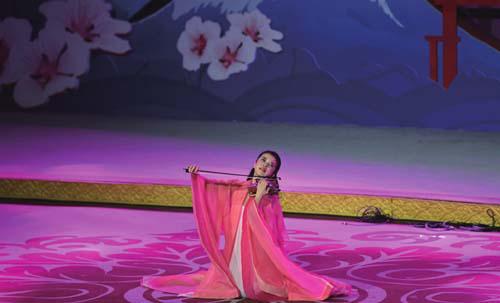Power of Civil Diplomacy
2018-10-31ByShiYongming
By Shi Yongming

With both China and Japan making efforts to shift the focus of bilateral relations from competition to common development and prosperity, the bilateral relationship has seen steady improvement in 2018. Following Chinese Premier Li Keqiangs visit to Japan in May, Japanese Prime Minister Shinzo Abe is visiting China from October 25 to 27, his fi rst offi cial trip in the nearly six years since he returned to power in December 2012.
Apart from changes in the international landscape, the thawing relationship between China and Japan is largely attributed to the constant people-to-people exchanges despite disputes over territorial and historical issues. Although some netizens from both countries are still posting infl ammatory remarks on the Internet, SinoJapanese civil diplomacy has maintained a mainstream trend of rational communication. In the process, both sides have become increasingly aware that reducing confrontation, increasing cooperation and improving bilateral relations are in line with the fundamental interests of their people. The rising consensus in the civil societies of the two countries has undoubtedly put China-Japan relations back on track.
In view of this, both sides will focus on non-governmental exchanges for promoting bilateral relationship. During his meeting with Abe in Vladivostok, Russia, on September 12, Chinese President Xi Jinping stressed that the two sides should carry forward the tradition of people-topeople exchanges and consolidate the social and public opinion foundation for bilateral ties. Abe, on his part, proposed that the two countries should expand mu- tual exchanges to more fi elds and improve their relations.
Expanding non-governmental exchanges is a goal in developing SinoJapanese relationship and also an essential approach. Against such a backdrop, the important role played by civil diplomatic activities such as the Beijing-Tokyo Forum in boosting bilateral bonds in the new era is receiving greater attention. Founded in 2005, the annual forum opened in Tokyo on October 14. Hundreds of guests and organizational representatives from China and Japan attended the event, contributing ideas for a sound relationship between the two countries.
Means of modern diplomacy
Diplomacy generally refers to a governments way of handling inter-state affairs, in line with the interests of its own people and winning public support. Therefore, civil communities assisting governments in bilateral interaction is common in modern diplomacy. In the 1950s, the Chinese Government proposed the concept of“civil diplomacy” since China had not established diplomatic relationships with other countries widely. As a result, semiofficial and civil organizations became an important force for China to engage with the international community. Since civil diplomacy focuses on people-to-people exchanges, Chinas policy aims at introducing its national conditions and governmental policies. It also attaches importance to knowing the rest of the world through non-governmental exchanges. The core goal is to enhance mutual understanding, build trust and promote bilateral relations through civil exchanges.
Since the 1980s, the United States has also embraced public diplomacy. The core of the U.S. public diplomacy theory is to influence the public of other countries through a variety of means so as to make an impact on foreign governmental policies. During President Jimmy Carters term from 1977 to 1981, the International Development Cooperation Agency was established and the Advisory Commission on Public Diplomacy was set up to advise and make recommendations on the U.S. governments activities. The subsequent Ronald Reagan administration established the National Endowment for Democracy(NED) and began to promote public diplomacy through non-governmental organizations, aiming to change the concepts of people from other countries and further infl uence their governments. After the end of the Cold War, the NED ignited the so-called color revolutions in many countries.
Chinese civil diplomacy is entirely different from U.S. public diplomacy.
In the 1990s, Track II diplomacy began to emerge in East Asia, parallel to the Track I diplomacy for official exchanges. Under Track II diplomacy, non-governmental organizations in specific fields organize in-depth discussions on sensitive issues under official guidance to support Track I diplomacy. These activities can also be deemed as part of civil diplomacy since they promote bilateral relationship and address multilateral issues by enhancing communication.
Civil diplomacy, rich in form but simple in nature, aims to bridge the gap between different countries and promote understanding between their peoples. Attaching great importance to civil diplomacy, Xi put forward the concept of people-to-people connectivity while proposing the Belt and Road Initiative, suggesting that mutual understanding among people be an important foundation for building sustainable relationships between countries and enriching Chinese diplomatic theories.
Narrowing the gap
The operation mechanisms of civil and governmental diplomacy differ greatly. The former generally depends on longestablished relations between the civil communities of different countries.
Civil diplomacy between China and Japan has developed with rich resources and experiences, prevailing for thousands of years, and leading to the two countries sharing their cultures. In ancient times, the Japanese culture was greatly influenced by traditional Chinese culture, while China has been influenced by Japan in the process of learning from the West in modern times. The Chinese characters used in the Japanese language also facilitate communication between the people of the two countries. The long cultural exchanges enabled the two countries to resume bilateral relations after wars in history.
The thaw in tension is also a result of the friendship between the two peoples. China treated the militarists in the Japanese Government and ordinary people differently during the Japanese war of aggression from 1931 to 1945. Many Japanese soldiers were transformed to anti-war activists by education during wartime. After the war, many Chinese families adopted the Japanese war orphans left behind in China. Most of the war orphans returned to Japan after the two countries normalized their relationship in 1972.
Semi-official and non-governmental associations in the two countries held exchange activities frequently in the early 1960s, when the Cold War prevailed. The extensive people-to-people exchanges became an important force in the early 1970s for the normalization of relationship between the two countries. Since then, non-governmental diplomacy has become more active, playing a signifi cant role in facilitating mutual communication, especially when disputes arise.
However, the civil diplomacy between China and Japan still has a long way to go. The results of a survey released during this years Beijing-Tokyo Forum showed that there are still uneasy feelings. Despite a greater understanding of the international landscape and the concept of building a community with a shared future for mankind, the gap between the two countries has not yet narrowed. It makes the promotion of Sino-Japanese people-to-people ties still an arduous task.
